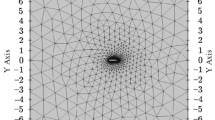Abstract
An iterative method from the class of completely implicit methods (CIM) is proposed for solving the equation of the velocity potential of elliptical-hyperbolic type. The advantage of the proposed method compared to other CIM schemes is demonstrated in application to mixed perfect gas flows in a nozzle of a given shape. Accuracy issues, rate of convergence, and various techniques of ensuring stability in the hyperbolic region are discussed.
Similar content being viewed by others
References
F. Anderson, J. Tannehill, and R. Pletcher, Computational Fluid Mechanics and Heat Transfer [Russian translation], Mir, Moscow (1990).
Numerical Methods in Fluid Dynamics [Russian translation], Mir, Moscow (1981), pp. 9–79.
A. A. Samarskii and E. S. Nikolaev, Methods of Solution of Grid Equations [in Russian], Nauka, Moscow (1978).
D. Peaceman and H. Rachford, “The numerical solution of parabolic and elliptic differential equations,” SIAM J.,3 28–41 (March 1955).
T. Holst and J. W. Ballhaus, “Fast conservative schemes for the full potential equation applied to transonic flows,” AIAA J.,17 No. 2, 145–152 (1979).
T. L. Stone, “Iterative solution of implicit approximation of multidimensional partial differential equations,” SIAM J.,5, 53–558 (Sept. 1968).
M. Hafez, E. Murman, and J. South, “Artificial compressibility methods for numerical solution of transonic full potential equation,” AIAA J.,17, 838–844 (Aug. 1979).
V. A. Veretentsev, V. A. Mechenova and G. S. Roslyakov, “Numerical analysis of gas flows in channels and nozzles using potential equations,” in: Nonstationary Gas Flow with Shock Waves [in Russian], Leningrad (1990), pp. 317–328.
G. Schneider and M. Zedan, “A modified strongly implicit procedure for the numerical solution of field problems,” Numerical Heat Transfer,4, 1–19 (Jan. 1981).
Pepper and Harris, Trans. ASME, ser. I: J. Fluid Eng.,99, 782 (Dec. 1977).
P. Laval, “A nonstationary method for calculating transonic nozzle flows,” in: Numerical Methods in Fluid Mechanics [Russian translation], Mir, Moscow (1973), pp. 9–17.
M. Ya. Ivanov and V. V. Koretskii, “Calculation of flows in two-and three-dimensional nozzles by approximate factorization method,” Zh. Vychisl. Matem. i Mat. Fiziki,25, No. 9, 1365–1381 (1985).
Additional information
Translated from Chislennye Metody v Matematicheskoi Fizike, Published by Moscow University, Moscow, 1996, pp. 39–51.
Rights and permissions
About this article
Cite this article
Mechenova, V.A., Roslyakov, G.S. Using completely implicit methods to solve the direct problem of nozzle theory. Comput Math Model 8, 118–129 (1997). https://doi.org/10.1007/BF02405161
Issue Date:
DOI: https://doi.org/10.1007/BF02405161




